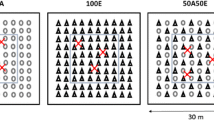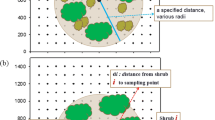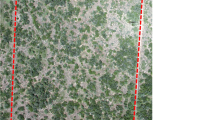Abstract
We tested whether both shrubs and grasses are able to develop similar active fine-root systems in the upper soil layer of the arid Patagonian Monte ecosystem with non-seasonal precipitation. We selected in the field shrub patches consisting of one isolated modal plant of the dominant shrub Larrea divaricata Cav., grass patches formed by one or more bunches of the dominant grass Stipa tenuis Phil. (15 cm diameter), and mixed patches consisting of one individual of L. divaricata with bunches of S. tenuis under its canopy. We assessed the biomass, regrowth, and activity of fine roots (diameter <1.4 mm) of each species in the upper soil (50 cm depth) of each patch type at 3-month intervals. We also measured the N concentration in fine roots to estimate the relative contribution of each species to fine-root biomass of mixed patches. We injected Li+ in the soil as a chemical tracer to detect fine-root activity of each species in the upper soil. Fine-root biomass was higher in mixed patches than in grass patches while fine-root biomass in shrub patches did not differ from the two former. We did not find differences in fine-root regrowth among patch types. Li+ injection provided evidence of active fine roots of both species in the upper soil when it was wet. N concentration in fine roots suggested the prevalence of fine roots of L. divaricata in the upper soil of mixed patches. Our results support evidence of the ability of fine roots of both the shrub and the grass species to occupy the upper soil. These findings did not support the two-layer model (H Walter, Ecology of tropical and subtropical vegetation, Oliver and Boyd, Edinburgh, 1971) and provide evidence of this model would be less applicable to arid ecosystems with non-seasonal precipitation. Further, our results highlighted some issues deserving more research such as the outcome of belowground competition between neighboring plants of both contrasting life forms, the eventual limited fine-root carrying capacity of the upper soil, and differences in fine-root lifespan between species of both contrasting life form.

Similar content being viewed by others
Abbreviations
- L:
-
Larrea divaricata patches
- S:
-
Stipa tenuis patches
- LS:
-
L. divaricata and S. tenuis patches
References
Baldi R, Albon SD, Elston D (2001) Guanacos and sheep: evidence for continuing competition in arid Patagonia. Oecologia 129:561–570
Baldi R, Pelliza-Sbriller A, Elston D, Albon S (2004) High potential for competition between guanacos and sheep in Patagonia. J Wildl Manage 68:924–938
Becker GF, Busso CA, Montani T, Burgos MA, Flemmer AC, Toribio MB (1997) Effects of defoliating Stipa tenuis and Piptochaetium napostaense at different phenological stages: root growth. J Arid Environ 35:269–283
Bertiller MB, Beeskow AM, Coronato F (1991) Seasonal environmental variation and plant phenology in arid Patagonia (Argentina). J Arid Environ 21:1–11
Bertiller MB, Ares JO, Bisigato AJ (2002) Multiscale indicators of land degradation in the Patagonian Monte, Argentina. Environ Manage 30:704–715
Bisigato AJ, Bertiller MB (1997) Grazing effects on patchy dryland vegetation in northern Patagonia. J Arid Environ 36:639–653
Böhm W (1979) Methods of studying root systems. Springer Verlag, Berlin
Cabrera AL (1976) Regiones fitogeográficas argentinas. Enciclopedia Argentina de Agricultura y Jardineria, 2nd edn. ACME, Buenos Aires, p 85
Callaway RM, Pennings SC, Richards CL (2003) Phenotypic plasticity and interaction among plants. Ecology 84:1115–1128
Canadell J, Jackson RB, Ehleringer JR, Mooney HA, Sala OE, Schulze ED (1996) Maximum rooting depth of vegetation types at the global scale. Oecologia 108:583–595
Casper B, Jackson RB (1997) Plant competition underground. Ann Rev Ecolog Syst 28:545–570
Coombs J, Hind G, Leegood RC, Tieszen L, Vonshsk A (1985) Analytical techniques. In: Coombs J, Hall DO, Long SP, Scurlock JMO (eds) Techniques in bioproductivity and photosyntesis. Pergamon Press, Oxford, pp 219–228
Coronato FR, Bertiller MB (1997) Climatic controls of soil moisture dynamics in an arid steppe of northern Patagonia, Argentina. Arid Soil Res Rehabil 11:277–288
Corre-Hellou G, Crozat Y (2005) Assessment of root system dynamics of species grown in mixtures under field conditions using herbicide injection and N15 natural abundance methods: a case study with pea, barley and mustard. Plant Soil 276:177–192
del Valle HF (1998) Patagonian soils: a regional synthesis. Ecología Austral 8:103–123
Gibbens RP, Lenz JM (2001) Root systems of some Chihuahuan desert plants. J Arid Environ 49:221–263
Gibson DJ (1988) The maintenance of plant and soil heterogeneity in dune grassland. J Ecol 76:497–508
Haase P, Pugnaire FI, Fernández EM, Puigdefábregas J, Clark SC, Incoll LD (1996) An investigation of rooting depth of the semiarid shrub Retama sphaerocarpa (L.) Boiss. by labeling of ground water with a chemical tracer. J Hydrol 177:23–31
Hipodonka MHT, Aranibar JN, Chirara C, Lihavha M, Macko SA (2003) Vertical distribution of grass and tree roots in arid ecosystems of Southern Africa: niche differentiation or competition? J Arid Environ 54:319–325
Jackson RB, Canadell J, Ehleringer JR, Mooney HA, Sala OE, Schulze ED (1996) A global analysis of root distributions for terrestrial biomes. Oecologia 108:389–411
Knoop WT, Walker BH (1985) Interactions of woody and herbaceous vegetation in southern Africa savanna. J Ecol 73:235–253
Kropfl AI, Cecchi GA, Villasuso NM, Distel RA (2002) The influence of Larrea divaricata on soil moisture and on water status and growth of Stipa tenuis in southern Argentina. J Arid Environ 52:29–35
Lambers H, Chapin FS III, Pons T (1998) Biotic influences. In: Lambers H, Chapin FS III, Pons T (eds) Plant physiological ecology. Springer Verlag, New York, pp 378–412
León RJC, Bran D, Collantes M, Paruelo JM, Soriano A (1998) Grandes unidades de vegetación de la Patagonia extraandina. Ecología Austral 8:125–144
Montaña C, Cavagnaro B, Briones O (1995) Soil water use by co-existing shrubs and grasses in the southern Chihuahuan Desert, Mexico. J Arid Environ 31:1–13
Morello J (1958) La Provincia Fitogeográfica del Monte. Opera Lilloana II, Tucumán
Norusis MJ (1997) SPSS advanced statistic 7.5. SPSS 579, Chicago
Noy-Meir I (1973) Desert ecosystem: environment and producers. Ann Rev Ecolog Syst 4:25–52
Ogle K, Reynolds JF (2004) Plant responses to precipitation in desert ecosystems: integrating functional types, pulses, thresholds, and delays. Oecologia 141:282–294
Ogle K, Wolpert RL, Reynolds JF (2004) Reconstructing plant root area and water uptake profiles. Ecology 85:1967–1978
Peek MS, Leffler AJ, Ivans CY, Ryel RJ, Caldwell MM (2005) Fine root distribution and persistence under field conditions of three co-occurring Great Basin species of different life form. New Phytol 165:171–180
Peláez DV, Distel RA, Bóo RM, Elia OR, Mayor MD (1994) Water relations between shrubs and grasses in semi-arid Argentina. J Arid Environ 27:71–78
Pigliucci M (2001) In: Hopkins J (ed) Phenotypic plasticity: beyond nature and nurture (syntheses in ecology and evolution). University press, Baltimore, Maryland, USA
Reynolds HL, Hungate BA, Chapin FS III, D, Antonio CM (1997) Soil heterogeneity and plant competition in an annual grassland. Ecology 78:2076–2090
Reynolds JF, Kemp PR, Tenhunen JD (2000) Effects of long-term rainfall variability on evapotranspiration and soil water distribution in the Chihuahuan desert: a modeling analysis. Plant Ecol 150:145–159
Reynolds JF, Kemp PR, Ogle K, Fernandez RJ (2004) Modifying the `pulse-reserve’ paradigm for deserts of North America: precipitation pulses, soil water, and plant responses. Oecologia 141:194–210
Rodríguez MV (2002) Cambios en la estructura horizontal y vertical del canopeo y del sistema radical inducidos por disturbio pasturil en el NE del Chubut. Degree thesis. Universidad Nacional de la Patagonia San Juan Bosco, Argentina
Rodríguez MV, Bertiller MB, Sain CL (2007) Spatial patterns and chemical characteristics of root biomass in ecosystems of the Patagonian Monte disturbed by grazing. J Arid Environ 70:137–151
Ryser P, Lambers IL (1995) Root and leaf attributes accounting for the performance of fast- and low-growing grasses at different nutrient supply. Plant Soil 170:251–265
Sala OE, Golluscio RA, Lauenroth WK, Soriano A (1989) Resource partitioning between shrubs and grasses in the Patagonian steppe. Oecologia 81:501–505
Schenk HJ, Jackson RB (2002) The global biogeography of roots. Ecol Monogr 72:311–328
Schwinning S, Davis K, Richardson L, Ehleringer JR (2002) Deuterium enriched irrigation indicates different forms of rain use in shrub/grass species of the Colorado Plateau. Oecologia 130:345–355
Soil Survey Staff (1998) National soils handbook. USDA-NRCS, Washington DC
Soriano A (1950) La vegetación del Chubut. Rev Argent Agron 17:30–66
Sun G, Coffin DP, Lauenroth WK (1997) Comparison of root distributions of species in North American grasslands using GIS. J Veg Sci 8:587–596
Súnico CA (1996) Geología del cuaternario y ciencia del suelo: Relaciones geomórficas-estratigráficas con suelos y paleosuelos. PhD diss. Universidad de Buenos Aires Press, Buenos Aires, p 226
Van der Krift TAJ, Berendse F (2002) Root life spans of four grass species from habitats differing in nutrient availability. Funct Ecol 16:198–203
Walter H (1971) Ecology of tropical and subtropical vegetation. Oliver and Boyd, Edinburgh
Whitford W (2002) Decomposition and nutrient cycling In: Whitford W (ed) Ecology of desert systems. Academic Press, pp 235–274
Wilcox C, Ferguson JW, Fernandez GCJ, Nowak RS (2004) Fine root growth dynamics of four Mojave Desert shrubs as related to soil moisture and microsite. J Arid Environ 56:129–148
Acknowledgements
This research was funded by PICTs 08-06027, 08-11131, 08-20454 BID 1201-1728/OC-AR of the National Agency for Scientific and Technological Promotion. M.V. Rodríguez fellowship is supported by CONICET (National Research Council of Argentina). We thank Gustavo Zamora, Dariana Vargas and Diego González Zevallos for their help in the fieldwork. We also acknowledge to Fermín Sarasa who allowed access to the study area in Estancia San Luis. Two anonymous reviewers made helpful comments on this manuscript.
Author information
Authors and Affiliations
Corresponding author
Additional information
Responsible Editor: Tibor Kalapos.
Rights and permissions
About this article
Cite this article
Rodríguez, M.V., Bertiller, M.B. & Bisigato, A. Are fine roots of both shrubs and perennial grasses able to occupy the upper soil layer? A case study in the arid Patagonian Monte with non-seasonal precipitation. Plant Soil 300, 281–288 (2007). https://doi.org/10.1007/s11104-007-9415-1
Received:
Accepted:
Published:
Issue Date:
DOI: https://doi.org/10.1007/s11104-007-9415-1




